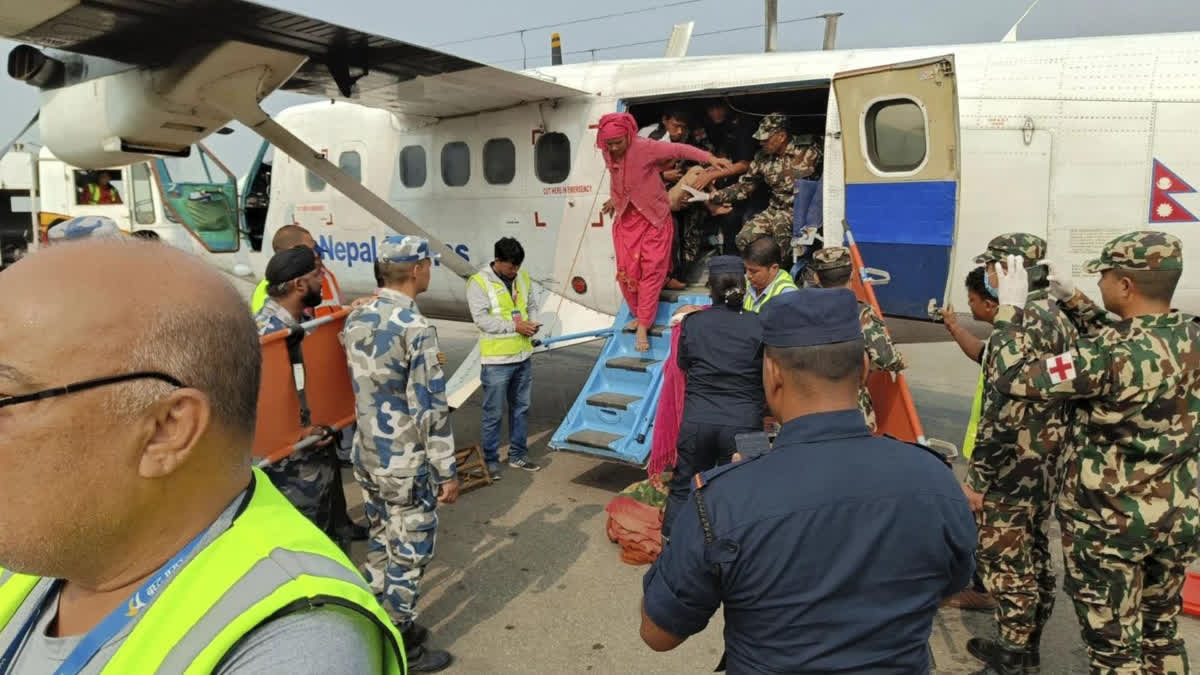Kathmandu : Thousands of people in western Nepal's mountainous region were forced to spend Saturday night under the open sky in the biting cold after a strong earthquake in the area killed 157 people and left a trail of destruction.
Bhawana Pun, who woke up Friday midnight after her house was shaken by the 6.4 magnitude earthquake in the Nalgad Municipality of Jajarkot district, still recalls the terror due to which she could not sleep on Saturday night too. The whole night she witnessed the vehicular movement on the road and the snoring of her neighbours who were sleeping in the open near her place.
She had no courage to go inside the cracked house as aftershocks were occurring time and again. "The houses have been severely damaged (because of the earthquake). Thus, people are sitting outside of their houses," said a local resident from Jajarkot, the epicentre of the earthquake, the most devastating in the country since 2015.
Jajarkot, about 500km northwest of Kathmandu, and Rukum districts of western Nepal were worst affected by the quake. About 253 people were injured in the quake. Around 159 aftershocks were recorded on Saturday, Nepal's National Earthquake Monitoring and Research Centre said. The Ministry of Home Affairs has dispatched initial relief supplies via the Army's helicopters. Prime Minister Pushpa Kamal Dahal 'Prachanda' on Saturday toured the quake-hit region with a medical team.
During the visit, he gathered information about the extent of the damage and inspected the affected areas. Later, he returned to Surkhet from Jajarkot, along with seven injured people and their family members. The Nepal government has said it is not in a hurry to seek foreign help for search and rescue operations and in the management of relief distribution and other logistics in the wake of the devastating earthquake.
We are yet to make any decision on accepting foreign aid, Prachanda said during the visit to the quake-affected areas. Speaking to the Kathmandu Post newspaper, a government secretary said the country is capable of dealing with the aftermath of the disaster. We have enough stock of logistical materials that we received during the Covid pandemic. We have trained personnel and enough supplies for relief and rehabilitation, the secretary said.
A Cabinet meeting, chaired by Prime Minister Prachanda on Sunday, is expected to decide on a special relief package for the victims of the quake. The government on Saturday decided to provide Rs. 50 million each to Jajarkot and Rukum West districts for immediate relief to the victims. The disaster management committee will also meet on Sunday after the Cabinet meeting. State security agencies, in coordination with local government and humanitarian organisations, have mobilised teams for search and rescue operations following the earthquake.
Close to 4,000 personnel from the Nepal Army, the Armed Police Force and the Nepal Police have been deployed in parts of Jajarkot and Rukum districts for rescue operations. Dozens of volunteers from the Nepal Red Cross Society and other organisations have been mobilised. According to Nepal Army spokesperson Brigadier General Krishna Bhandari, personnel from three battalions, including medical and aviation teams, have been sent to the two districts hit hardest by the earthquake.
A battalion has anywhere between 800 and 1,000 personnel. Many of the soldiers mobilised are trained to search collapsed structures for people and to provide quick responses. We primarily focused on search and rescue operations on day one. As the first 72 hours are considered the golden period [for successful rescue], we will prioritise search and rescue for a few more days, Nepal Army spokesperson Brigadier General Krishna Bhandari told the Kathmandu Post. However, relief distribution too will go hand in hand from now onward.
The Army is using five aircraft, including a Sky Truck, to ferry rescue and medical teams to affected areas while also airlifting the injured and deceased. Deputy Inspector General Kuber Kadayat, also the Nepal Police spokesperson, said hundreds of people have been affected by the disaster. However, as they were more focused on search and rescue, details of the affected are yet to be ascertained.
We will start collecting data on the affected and the number of the houses damaged or destroyed once the search and rescue phase is over, he told the paper. Because the earthquake destroyed bridges and triggered landslides in places, rescue teams found it difficult to reach the affected areas. Earthquakes are common in Nepal, which is situated on the ridge where the Tibetan and Indian tectonic plates meet and advance two meters closer to one another every century which results in pressure which is released in the form of earthquakes.
Also Read



